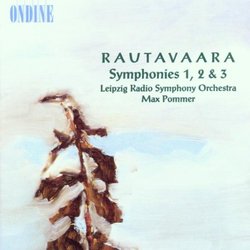Interesting!
Guna | DELHI, India | 06/30/2006
(3 out of 5 stars)
"The 1st symphony is more tonal than the others, and with many melancholy and sinister undertones, and the touches of bird calls add some atmosphere - remaniscent of Cantus Arcticus (qv). The second is very dissonant, and interesting in its way. The third, in my opinion the best and most interesting, has contrasts, mixing tonality and atonality from the 1st and 2nd symphonies respectively, and also mixing romanticism with 12-tone serialism - the 1st mvt seems to come out of silence, with some short runs on the wind instruments. The "Sehr Schnell" mvt, my favourite of all the CD tracks, is a very lively dance-like movement.
I recommend this CD to those who generally like modern symphonies."
First three symphonies - the birth, expansion and synthesis
Crt Sojar Voglar | Ljubljana, Slovenia | 07/31/2004
(4 out of 5 stars)
"I think this would be the perfect description of first three symphonies written by a composer who started his music writting career in the beginning of fifties in 20th century. First three symphonies display three different composers. If you listen to these works without knowing who the composer is, you will not say the same composer did it. Well, nearly. Since the main energy is reserved for slow movements which is Rautavaara's speciality, there are some similar points in each of these three works.
First symphony is surprisingly in only two movements (the composer denied previous version which had four movements). The first movement has some similarities with late works, but the orchestration is more simple and close to Shostakovich. The second movement is a short scherzo which brings Prokofjev to mind. I don't think it was a good idea to conclude the symphony with so short intermezzo like piece. The listener will probably expect more.
Second symphony has four movements. Again it shows how composer prefers slow movements. The second and fourth which are fast are also very short. The relatively clear tonality from the first symphony has dissapeared, even if triads have not. This symphony is a bit too abstract to become popular.
Third symphony, the most mature early work of the composer turns back to tonality (d minor), but contains many new elements of music development, including dodecaphony. Dodecaphony is frequently atonal, but not in Rautavaara's symphony. So it is possible to make dodecaphony simple and nice to listen! First movement is a organic, elemental music, which brings Bruckner to mind. Second movement is slow and is a weak point in the symphony. Come on, Rautavaara, write something agile! Nobody enjoys symphonies if they have three slow movements and only one fast (and short!) one. Third and fourth movement mix perfectly with the first movement.
The recording is excellent. How the heck can the orchestra make such pianissimo in the beginning of the third symphony? Wow!
"
The first two symphonies of this uneven composer are ho-hum,
Christopher Culver | 03/08/2008
(3 out of 5 stars)
"The first three symphonies of Finnish composer Einojuhani Rautavaara have been recorded several times now, but this Ondine disc (originally released in 1990 and re-released in 1995) is the only place to hear them all together. Max Pommer, a friend of the composer, leads the Leipzig Radio Symphony Orchestra.
Rautavaara wrote his Symphony No. 1 in 1955, but it appears here in a 1988 revision. The work is highly reminiscent of Shostakovich, whom the young Finnish modernists of those times admired. While it's all completely listenable, I feel it is more the fulfillment of a student's assignment to imitate the Russian composer than a significant new acheivement. I should mention that in 2003 Rautavaara revised the piece yet again to add a slow movement between the two main ones, though as the slow movement is based on a song he wrote in the '50s the spirit of the piece is preserved. This latest version can be heard on the recent Ondine Book of Visions hybrid SACD.
The Symphony No. 2 dates from 1957 and shows Rautavaara embracing modernism, though in its early 20th century form (especially Stravinsky) instead of the contemporary Darmstadt scene. All musical material of this four-movement work is derived from seven Preludes for piano written around the same time, and in orchestrating it Rautavaara kept it small. Indeed, it often seems chamber music, though the 1984 revision heard here expands the orchestration slightly. While moments of this symphony are interesting, all in all I think it lacks direction.
If the first two symphonies seem fairly minor and derivative (in a bad way) the "Symphony No 3." (1959-1960) might ultimately stand as Rautavaara's greatest achievement. Here the composer embraced twelve-tone serialism, but his application of the method, however, is totally unlike the pointillistic music of the Darmstadt group. It's not completely like the atonal expressionism of Berg either. Instead, incredibly enough, it sounds of all things like Bruckner with its titantic spans, Bruckernian orchestration, clear use of themes, and tonal finale. While I prefer more abstract serialism, it's neat to see someone following in Berg's footsteps in turning the dodecaphonic technique to something palatable to more sensitive listeners.
Rautavaara's music for the last several decades has been highly repetitive and hollow, with some pieces consisting of little more than appallingly long major triads over a pedal point in the strings. Nonetheless, I think the the Symphony No. 3 is something worth hearing for fans of 20th century repertoire. I could point out that a disc on Naxos has the piece at budget price, though the quality of that performance by the Royal Scottish National Orchestra conducted by Lintu is somewhat lesser than here. I've not yet heard the new Ondine disc with Segerstam conducting."

